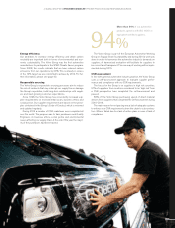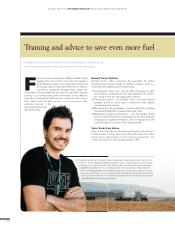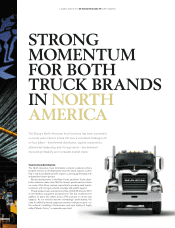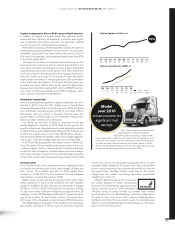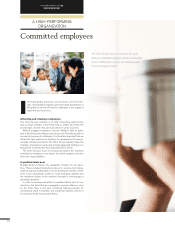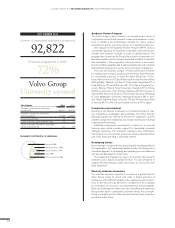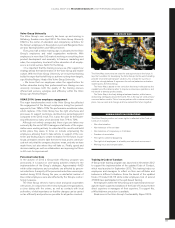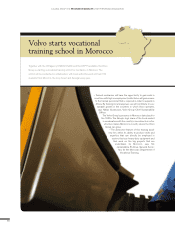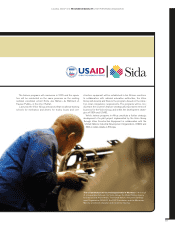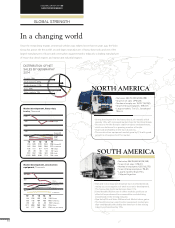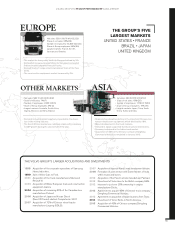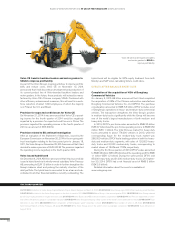Volvo 2014 Annual Report Download - page 62
Download and view the complete annual report
Please find page 62 of the 2014 Volvo annual report below. You can navigate through the pages in the report by either clicking on the pages listed below, or by using the keyword search tool below to find specific information within the annual report.
Europe 55%
North America 16%
South America 7%
Asia 19%
Other countries 3%
Geographic distribution of employees
Key fi gures 2014 2013
Number of permanent employees
at year-end 92,822 95,533
Number of temporary employees
and consultants 11,749 14,794
Share of women, % 18 17
Share of women, Board Members, % 20 17
Share of women, Presidents and other
senior executives, % 21 19
Number of permanent employees at year-end
92,822
Employee engagement in VGAS
72%
Volvo Group
University opened
KEY FIGURES 2014 Academic Partner Program
The Volvo Group is also involved in a comprehensive series of
cooperative ventures with research bodies and academic institu-
tions to advance the technologies needed for future product
development and to secure the access to competent employees.
One example is the Academic Partner Program (APP), which is
a systematic approach for long-term cooperation with selected uni-
versities and research institutes in areas of special interest. The
program aims to provide the Group with a picture of important col-
laborative partners and to increase the Group’s visibility to students
and researchers. The cooperation with universities is also impor-
tant for building capability and creating relationships with students
and potential employees to secure access to future competence.
There are two modules in place - Preferred Research Partners
for collaborative research projects and Preferred Talent Partners
for recruitment purposes. In total, the Volvo Group has 12 Pre-
ferred Talent Partners (T) and Preferred Research Partners (R) in
APP globally: National Institute of Technology, Karnataka (T) in
India, EM Lyon (T) and INSA Lyon (R, T) in France, Tsinghua Uni-
versity, Beijing (T) and Tongji University, Shanghai (T) in China,
Chalmers University of Technology, Göteborg (R, T), University of
Skövde (R), School of Business, Economics and Law, Göteborg
(T) and Mälardalen University, Västerås/Eskilstuna (R) in Swe-
den, North Carolina State University (T) and Pennsylvania State
University (R, T) in the U.S. and Sophia University (T) in Japan.
Competence development
Investing in the Group’s employees is a fundamental part of stay-
ing competitive, sustainable and profi table. The Volvo Group’s
training programs are offered at all levels for employees, and the
activities range from traditional and e-based training to individual
coaching and mentoring.
Individual competence development is based on a personal
business plan, which provides support for translating corporate
strategic objectives into individual objectives and contribution.
The purpose is to ensure that employees clearly understand their
role in the team and what is expected of them.
Developing talents
Every manager is responsible for assessing and developing talent in
the organization. The Leadership Pipeline provides the Group with a
structured approach to developing and preparing present leaders as
well as potential leaders for future roles.
The Leadership Pipeline has been set up jointly with research
institutes and is based on global research. It is also designed to
support the Volvo Group’s culture and values as well as the stra-
tegic objectives.
Diversity enhances innovation
To create the dynamics required to succeed at a global level the
Volvo Group needs to recruit and retain a broad spectrum of
employees with different backgrounds, experience and perspec-
tives. In the Volvo Group, diversity is considered to be a catalyst
for innovation and a source of competitiveness and profi tability.
Diversity challenges the status quo way of thinking and makes the
Group better able to understand customer needs, thus strength-
ening our market position. Diversity and inclusion have long been
prioritized within Volvo.
58
A GLOBAL GROUP 2014 BUSINESS MODEL A HIGH-PERFORMING ORGANIZATION



